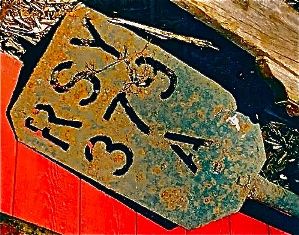| Back to Home Text | Back to LV Depot |
| At last, due diligence is winning the day! This self-portrait of Stew Mulligan in smile mode was snapped on the first of December 2011, when all should have been cold and snowy, rather than mimicking the first spring kiss of April. He's smiling because of the beehive of activity that is transforming Rochester Junction into a semblance of the intriguing place it was decades ago, when the Lehigh Valley Railroad bisected Plains Road. Tooling through this beloved site in October, Stew, being a genius of perception, exclaimed upon spotting a crater near the highway, "Hey, who dropped a bomb on Rochester Junction?!" A bit later, down the trail toward Mendon, he happened upon an abstraction jutting skyward and spewed quizzically, "For gosh sakes, since when did this place become a sculpture garden?!" Rushing back to hobo jungle down by the mineral spring, a terse letter was to be scrawled to the Sentinel editor, but it slipped his mind in a can o' beans. For you Millennials, Generation Next or Echo Boomers, beans were a staple to hobos, tramps and floaters, those poor souls ridin' the rails, stomachs forever growlin', in search of their future. |
| To commemorate that event (and a similar derailment at the same location in 1943), the Eagle Scout project of Ian Jackson turned that frumpy door into a reminder that Rochester Junction, which served about 700,000 trains, millions of people and untold millions of railroad cars, was a heavy duty, life and lore, gritty and growling, railroad place for three generations. Now comes the best part, something Stew dreamt of ever since Warren Wallace and his Mendon Foundation gang began resurrecting the spirit of the old Lehigh Valley more than a decade ago. The predominant feature of Rochester Junction, especially as it now can serve trail users, is the way the branch line flared off toward Honeoye Falls, Lima and beyond. With tracks laid out in a Y formation, trains, at least the locomotives pulling those trains, could do a sort of three-point turn, like we might do in our gas-guzzlers. |
| The wye was a favorite place for adventuresome kids, who often walked the branch tracks from Honeoye Falls for a day's viewing of the LV's mainline of rolling thunder. For a railroad setting, either leg was bucolic, since, by the 1960s, passenger train service was gone and branch traffic usually amounted to 5-10 short, slow freights per week. Mainline action, however, from New York to Buffalo via Mendon and Rush, still amounted to a couple dozen long trains per day. The Clover Street overpass (removed in 1977, after the Lehigh quit in "76") muted the loud chime horn of onrushing locomotives from the east. Often, just before our arrival at the junction, we'd detect a muffled train whistle blowing for the Quaker Meetinghouse crossing. Running as if pursued by a railroad cop, we'd race up one leg of the wye, just in time to catch sight of a speeding, thundering wall of freight cars and a kaleidoscope of light and shadow through the trees. As far as Stew recalls, no one ever turned an ankle or got a mug full of cinders in scampering to glimpse those trains. We never feared recrimination, either from getting smushed by a locomotive or collared by the law, for our days were days of freedom to roam and explore almost at will. Sure, vandals have existed since ancient times, but most fuzzy-faced scouting parties appreciated the elbow room and refrained from, as it were, "soiling the nest." |
 |
There's still work to be done on the wye, especially the deck/railing installations that will provide safe passage over those bridges (formerly designated "RSY 379 A" and "RSY 379 B"). One of those signs, found buried under cinders by the Stewmeister, will grace the finished product, as trail users access the presently undeveloped Great Bend Park from either direction. Swallowed in the swamp, the old hobo junction at the ruins of the former commercial mineral spring is gone forever. Otherwise, a reincarnation of Stew Mulligan's youthful vision of Rochester Junction's railroad era is proceeding at "full steam ahead!" |
| Please know that Honeoye Falls is my native home, branch trains passed by my window and pilgrimages to Rochester Junction have been ongoing for over sixty-five years. Contact me via snail mail at 108 Quail Run Circle, Leitchfield, KY. 42754; email at psworboys@gmail.com; or leave a message at (585) 697-4683. Thanks! |
Web Site Hosting by TRAIN WEB
The WNYRHS, Inc. P.O. Box 416, Buffalo, NY. 14231-0416 is an independent organization and has no affiliation with any other local or national group.
The Society is a fully qualified organization under 501 (C) (3) of the Internal Revenue Code and all donations to the Society are tax deductible.
©Copyright 1999 , WNYRHS Inc. all rights reserved